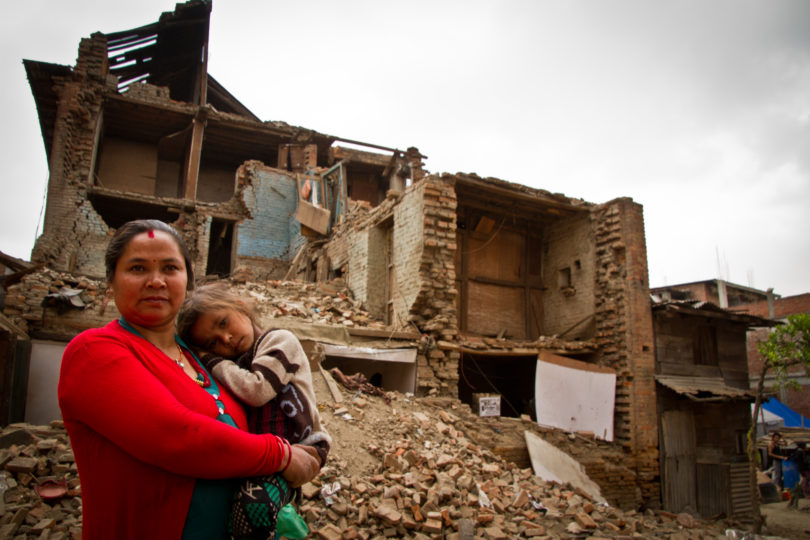In the wake of a natural disaster, displaced families face a number of hardships that may lead to poor health and nutrition. In these conditions, babies and mothers are particularly vulnerable, but their unique feeding needs are often overlooked in disaster relief efforts.
A new study from the University of Georgia highlights the need for humanitarian aid groups to be trained in safe infant and young child feeding protocols, following the 2015 earthquake in Nepal.
Researchers traveled to several earthquake relocation camps six months after the earthquake, where they interviewed new mothers about their experiences feeding their babies. The team was particularly interested in how well breastfeeding was supported in the camps.
Exclusive breastfeeding is recognized as the safest form of infant feeding for babies under six months old. Breastmilk is a complete nutrition source, keeps the baby hydrated and provides natural immune system support, which is crucial to infant health in the often-crowded conditions of post-disaster shelters.
Alternative feeding through formula can be dangerous for babies, and the World Health Organization recommends against mass formula distribution in emergencies. However, the team gathered data that suggests formula was given out without assessment or lactation support.
“Uncontrolled, untargeted formula distribution is very unsafe,” said Sarah E. DeYoung, an assistant professor of health policy and management in UGA’s College of Public Health and lead author on the study. “In the post-disaster setting where you have people living in relocation camps, it’s very unsafe because usually there’s not access to clean water or appropriate supplies to clean and sterilize bottles.”
Feeding bottles can easily be contaminated with bacteria, leading to serious health consequences and even death for infants.
“Unfortunately, it’s a rampant problem in the post-disaster context,” said DeYoung. “Groups bring formula and hand it to everyone without asking, and then mothers have this perception that bottle feeding is the thing to do because they’re receiving formula in their humanitarian packets.”
DeYoung says that this behavior is influenced by Western norms. Exclusive breastfeeding is far less common in the United States — only 19 percent — compared to the global average of 40 percent and 70 percent in Nepal.
Well-meaning people in the U.S. often donate baby formula without knowing that formula feeding can cause harm.
“They want to help because babies are so vulnerable,” said DeYoung, “but they’re just ill-informed.”
Myths about low milk supply may also fuel the assumption that formula is needed in a disaster scenario. Stress and undernourishment are often blamed for a drop in mothers’ milk supply, but the real issue, says DeYoung is the perception of a low supply.
When a mother thinks her supply is low because of stress associated with the disaster, and then switches to bottle feeding, her body assumes she is trying to wean and will adjust milk production because of this.
“Lactation support should be offered in humanitarian camps, so you can explain that simple cycle to the women, that each time you bottle feed, you are going to decrease your supply,” said DeYoung. “It’s a matter of having support and helping women overcome those myths they’ve been given.”
One Nepali myth contributing to mothers’ use of formula was the belief that because they’d lived through an earthquake, their milk was “bad,” or not enough. Still, DeYoung observed how other cultural norms supported breastfeeding. For example, women in relocation camps continued to make and serve jawaano soup to mothers, a spice traditionally used to boost milk supply.
Taking Nepal’s culture of breastfeeding into account would have provided better support for safe infant feeding after the earthquake, and DeYoung emphasizes the need for emergency response organizations to support safe feeding.
“The simple, low-tech intervention is asking mothers, are you breastfeeding? If they say yes and it’s going well, don’t give them formula,” she said, and if formula is necessary, the appropriate education and support needs to be in place to ensure the baby’s nutrition and safety.
The study, “Maternal perceptions of infant feeding and health in the context of the 2015 Nepal earthquake” published in the Journal of Human Lactation. It is available here: https://journals.sagepub.com/doi/full/10.1177/0890334417750144#articleShareContainer.
Co-authors on the study includes Manoj Suji, MS, of Tribhuvan University and Hannah G. Southall, MPH, at UGA’s College of Public Health.
– Lauren Baggett
Posted February 26, 2018
News release available at UGA Today. Additional coverage EurekAlert!, News Medical, and March 2 ASPPH Friday Letter.
Related stories:







